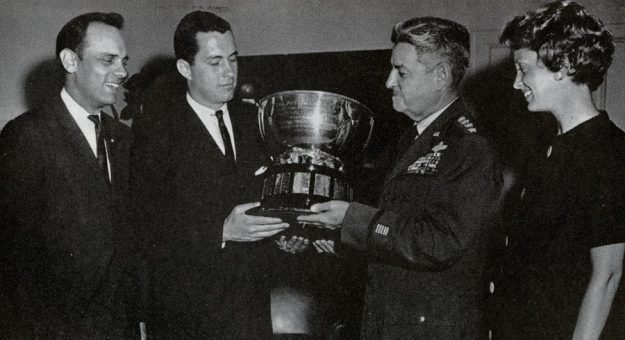As the Cold War’s temperature escalated, LeMay returned to the United States in 1949 to head the Strategic Air Command, which operated nuclear-armed bombers from bases generally located a long way from American civilization. As a four-star general, LeMay innately understood that to maintain his troops’ morale, he had to offer them diversion from their constant, hair-trigger readiness against a Soviet attack. He almost immediately ordered creation of an auto hobby shop at Offutt Air Force Base outside Omaha, Neb., where SAC was headquartered.
LeMay arranged for the Ionia Body Co., a longtime supplier to the U.S. auto industry, to donate a fiberglass sports car body to the Offutt shop. At Ramey Air Force Base in Puerto Rico, Air Force officers had begun holding impromptu races on an excess runway and invited LeMay to attend.
Encouraged, LeMay ordered all SAC bases to establish morale operations for their personnel, including activities surrounding cars. With thousands of SAC personnel recently returned from Europe, sports car racing was a natural leisure-time choice, which LeMay believed would encourage airmen to reenlist, with the side benefit of publicity.
Soon after the Watkins Glen debacle, LeMay approved a national championship sports car race for October 1952 at Turner Air Force Base in Georgia. LeMay showed up with his Allard. Another attendee was the pioneering TV personality Arthur Godfrey, a serious fan of sports cars and racing.
The initial trophy race around the 4.5-mile temporary circuit went to Chicago resident James Simpson, aboard a modified O.S.C.A. Fitch and his Cunningham won the four-hour main event in front of some 60,000 onlookers, at the time the largest crowd ever to attend a sporting event in southern Georgia. Perhaps more noteworthy was the presence of Wacker, the other party involved in the Watkins Glen accident, who had become president of the SCCA.
Wacker was thrilled by LeMay’s unforced enthusiasm for imported cars, and the Turner program’s runaway success led both men to agree on an expanded, Air Force-supported skein of races beginning in 1953.
The schedule combined regional events taking place in the remaining communities that still supported open-road events backed up with a new slate of “national” races held at Air Force bases. The first such “national” took place in February 1953 at MacDill Air Force Base outside Tampa, where Fitch won again in his Cunningham, with 90,000 crowding the fences.
Success at MacDill led LeMay to immediately schedule another race for April 1953 at Bergstrom Air Force Base outside Austin, Texas. Much bigger names from farther afield were on hand for this race, including Phil Hill, Carroll Shelby, West Coast Porsche importer Johnny von Neumann and the day’s victors: Jim Kimberley, Boris Said Sr., William Spear and Tom Newcomer.
The Pentagon prohibited LeMay from driving himself, but the general nonetheless approved a schedule of SCCA-sanctioned competitions on SAC bases that lasted through 1954, conducted in accordance with a LeMay-ordered, 72-page SAC manual covering every detail of organizing a race.
The culmination was the 1954 race at Andrews Air Force Base outside Washington, D.C. Spear won it over Kimberly and was presented his trophy in the Oval Office by President Dwight Eisenhower.
Twenty different Air Force bases presented 29 sports car races through 1954. When SAC enlistment rates didn’t improve, the Air Force ended the races. In addition to the recruitment issues, several lawmakers objected that the cost of staging the races far outstripped any income via ticket and concession revenues.
It’s still disputable that LeMay’s publicly expressed love of fast cars and his support for SAC-hosted races, provided the SCCA with critical breathing room while permanent natural-terrain road courses such as Lime Rock Park in Connecticut, Laguna Seca in California and the permanent road course in Watkins Glen were built.
More than any single individual, LeMay guaranteed sports car racing an American future. The great 1950’s boom in American sports car ownership would arguably have lost much of its vigor if not for LeMay’s timely and influential help.
Before its alliance with SAC ended, the SCCA honored LeMay with its Woolf Barnato Trophy for a life’s work supporting sports cars.
LeMay was known to use his lifetime pass to SCCA events until he died in 1990. He was enshrined into the SCCA Hall of Fame in 2007.
